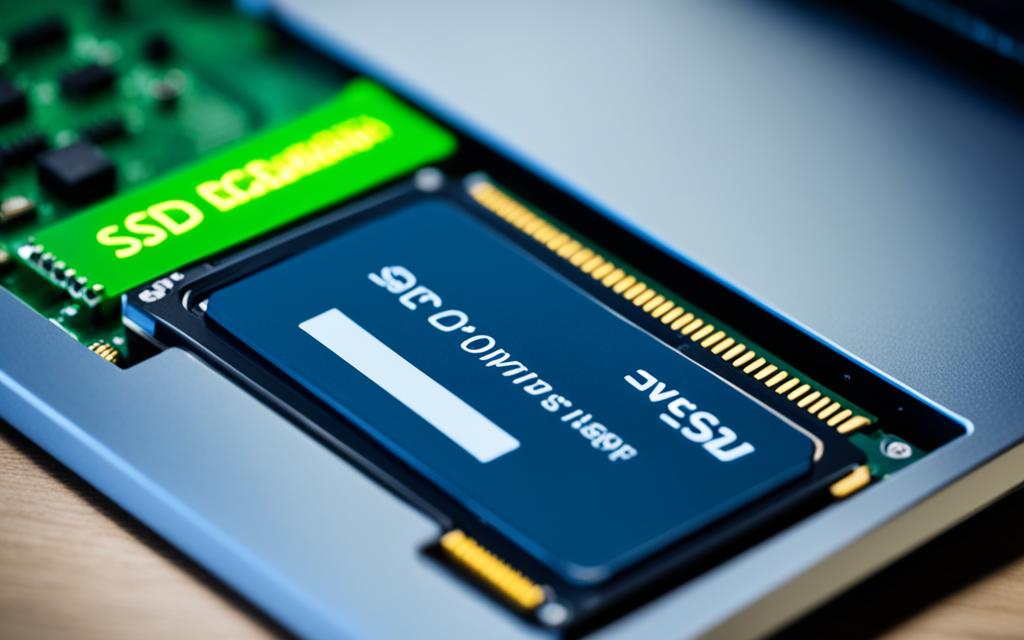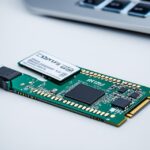Table of Contents
Is it important to format a new SSD? Yes, it is. This step makes sure your SSD works well with your computer. SSDs are more popular now, especially for Windows users. Knowing why formatting matters helps, whether you’re a newbie or thinking of giving yours away. Understanding formatting’s role is key. It prevents problems like data corruption or not working right on different computers.
Windows, macOS, and Linux all need SSDs formatted in special ways for the best work. Also, removing your files from the SSD is important for privacy1. This means the new owner starts fresh without your data.
Key Takeaways
- Formatting is a must for new SSDs, so they work with your system.
- It also erases old data, making it safer to sell or give away.
- For best performance, use the right file system like NTFS for Windows or APFS for macOS2.
- The Disk Management tool in Windows makes formatting easy.
- Always back up your files before formatting to avoid losing them.
- TRIM support is important to keep your SSD running smoothly1.
Understanding Solid State Drives (SSDs)
Solid State Drives, or SSDs, are a big step forward in storing data. They don’t use spinning disks like old Hard Disk Drives (HDDs). Instead, SSDs store information on flash memory. This makes them much quicker and more dependable. The cool thing about SSDs is they don’t have moving parts. This means they’re less likely to break down. You can find SSDs in various types, like SATA and NVMe, fitting different tech needs.
What is an SSD?
An SSD is a storage device that keeps data safe even when it’s off. It’s faster at transferring data than HDDs. This makes SSDs a hot topic when talking about performance. They really shine by starting your computer quickly and opening programs in no time. This shows why many prefer SSDs.
Benefits of Using SSDs Over Traditional Hard Drives
Using an SSD has lots of benefits, both for fun and work. They make computers faster and use less power. This is great for gadgets you carry around. Here’s what you’ll notice:
- Enhanced data access speeds, leading to lower boot times and quicker application launches.
- Increased durability due to the lack of moving medicine parks, reducing the risk of mechanical failure.
- Lower power consumption, positively impacting battery life in laptops and mobile devices.
- Quieter operation and reduced heat generation, offering a more comfortable user experience.
As more people look for reliable and efficient storage, SSDs are getting a lot of attention. They need to be formatted right for tasks like moving data or installing new systems. Knowing about SSD tech helps in making them work best. This knowledge is key for top performance and safe data345.
Why Would You Need to Format an SSD?
Formatting an SSD is crucial when you’re setting up a new device. It makes sure the SSD works well with your operating system. Usually, new SSDs come unformatted1.
To get them working, you have to choose a file system like NTFS or APFS. This depends on whether you use Windows or another platform. Formatting is vital for making the SSD work smoothly with your system1.
Initial Setup for Compatibility with Your OS
Formatting your SSD lets you adjust it to your specific needs. This is especially true when installing a new operating system. You can format the SSD before or during the OS installation1.
There are various file systems available, including FAT32, exFAT, and NTFS. They offer different levels of compatibility. For Windows users, there are easy tools like Disk Management for formatting. There are also other options like EaseUS Partition Master Professional and MiniTool Partition Wizard Free Edition5.
Preparing an SSD for Resale or Donation
If you’re planning to sell or donate your SSD, a secure wipe is important. It completely removes all data, protecting your personal information. This also makes the SSD like new again2.
Kinston’s SSD Manager and other third-party apps can help with this secure deletion. A well-prepared SSD not only benefits the new user but also follows data security best practices2.
Learn more about format SSD procedures to handle different scenarios before using or selling your SSD152.
Do You Need to Format a New SSD Drive?
Choosing to format a new SSD depends on how you plan to use it. Getting familiar with SSD formatting scenarios helps decide if you need to format. This or if it’s better not to.
Common Scenarios Requiring Formatting
Some situations absolutely require formatting an SSD. Most new SSDs are unformatted, needing setup before use. SSD not requiring formatting usually means it was already prepared with a compatible OS. Key instances are:
- Formatting ensures the SSD works right when you’re putting a new OS on it, like Windows, Mac, or Linux1.
- Before reusing an SSD with private data, formatting it is a must to wipe everything clean5.
When Formatting is Optional
Sometimes, you might not have to format an SSD. If it’s already formatted and you’re just switching systems with the same OS, a reformat might be unnecessary. Check the data condition and see if performance could benefit from optional SSD formatting. Also, if the SSD’s file system matches the new system, you might leave it as is.
Deciding when to format SSD boils down to what you need and how you want to use the SSD15.
Steps to Format an SSD in Windows
To start formatting an SSD in Windows, use the Disk Management tool. It’s found by right-clicking the Start button and selecting ‘Disk Management’. Once open, find the SSD you need to format. After finding it, right-click and pick the ‘(Category Name)’ option. Then, indicate the file system and allocation size6. Remember, NTFS is best for Windows SSDs6.
Using Disk Management Tool
The Disk Management tool makes formatting easy. First, choose your SSD carefully to avoid deleting important data. For Windows, NTFS is the recommended file system. If you need it to work with macOS too, pick exFAT1.
Quick Format vs Full Format
When deciding to format, you’ll see Quick Format and Full Format options. Quick Format is quicker and better for your SSD’s health7. Full Format is detailed but best for HDDs. It might shorten SSDs’ lives. Always select ‘Quick Format’ to format safely and efficiently7.
FAQ
What is the process for formatting a new SSD drive?
To format a new SSD drive, start with the Disk Management tool in Windows. Find and right-click the SSD. Choose ‘Format’ and select NTFS or another suitable file system for Windows.
Why is formatting essential for optimal SSD performance?
Formatting makes sure your SSD works well with the operating system. It improves performance and prepares it for managing data. This prevents data loss and compatibility problems.
How does formatting help with secure erasure of personal data?
Formatting securely deletes personal data from an SSD. This makes sure your info can’t be recovered. It’s important for keeping your privacy when you give away or sell the device.
What are the advantages of Solid State Drives over Hard Disk Drives?
SSDs are faster at accessing data and starting up. They’re more reliable without mechanical parts and use less power. They’re also quieter and produce less heat, making for a better experience than HDDs.
In what scenarios is formatting required for a new SSD?
You’ll need to format a new SSD when setting up a fresh operating system. It’s also needed when switching from older drives for the best compatibility and performance.
Are there situations when reformatting an SSD is not necessary?
Reformatting isn’t always needed. If you’re moving an SSD to another computer with the same OS, it might be okay without it. Yet, managing your data is still key.
What is the difference between Quick Format and Full Format?
A Quick Format quickly clears the file table but doesn’t check the disk thoroughly. It’s better for SSDs. On the other hand, a Full Format does deep checks and cleans data. It’s good for HDDs but may harm SSDs by reducing their lifespan.
Source Links
- https://www.easeus.com/partition-master/format-new-ssd.html – How to Format New SSD in Windows 10/11 [100% Working Solutions]
- https://www.kingston.com/en/blog/personal-storage/how-to-format-ssd – How to Format Your SSD
- https://www.kingspec.com/news/how-to-format-a-solid-state-drive-a-step-by-step-guide.html – How to Format a Solid-State Drive: A Step-by-Step Guide
- https://grok.lsu.edu/Article.aspx?articleid=20019 – Erasing a Solid State Drive (SSD)
- https://www.partitionwizard.com/partitionmagic/how-to-format-ssd.html – 3 Different Ways to Free Format SSD with No Harm to SSD – MiniTool Partition Wizard
- https://www.lifewire.com/format-ssd-5184623 – How to Format an SSD
- https://www.howtogeek.com/765626/how-to-format-a-hard-drive-or-ssd-on-windows-11/ – How to Format a Hard Drive or SSD on Windows 11








